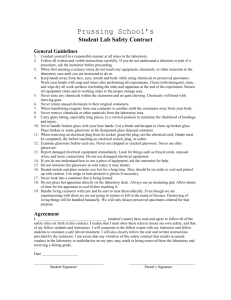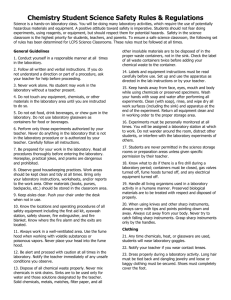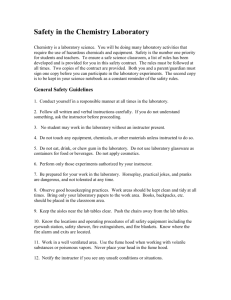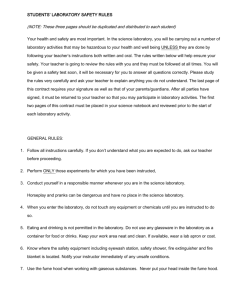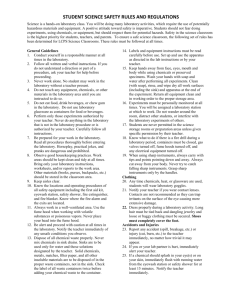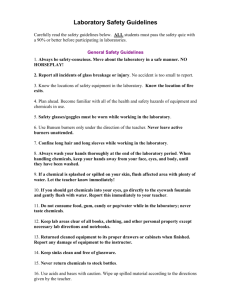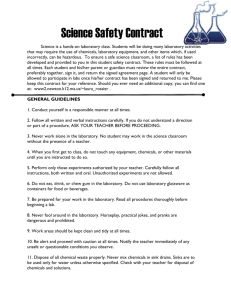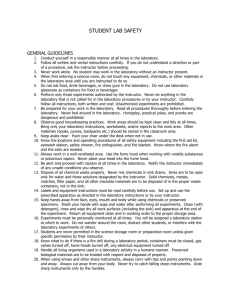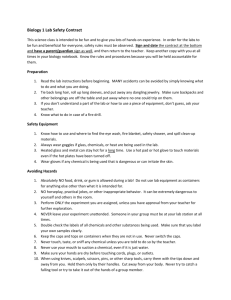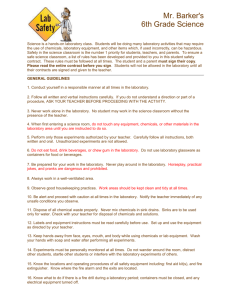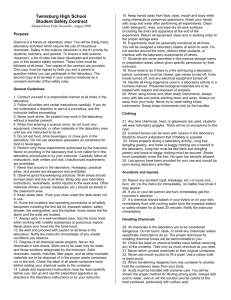Safety Contract
advertisement
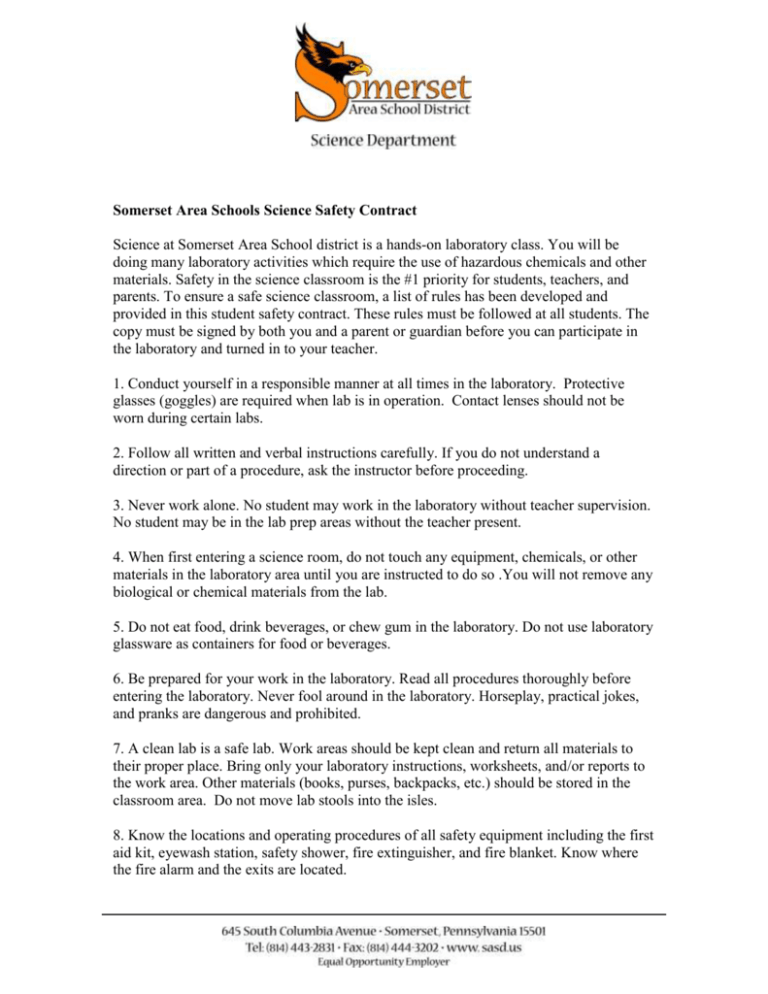
Somerset Area Schools Science Safety Contract Science at Somerset Area School district is a hands-on laboratory class. You will be doing many laboratory activities which require the use of hazardous chemicals and other materials. Safety in the science classroom is the #1 priority for students, teachers, and parents. To ensure a safe science classroom, a list of rules has been developed and provided in this student safety contract. These rules must be followed at all students. The copy must be signed by both you and a parent or guardian before you can participate in the laboratory and turned in to your teacher. 1. Conduct yourself in a responsible manner at all times in the laboratory. Protective glasses (goggles) are required when lab is in operation. Contact lenses should not be worn during certain labs. 2. Follow all written and verbal instructions carefully. If you do not understand a direction or part of a procedure, ask the instructor before proceeding. 3. Never work alone. No student may work in the laboratory without teacher supervision. No student may be in the lab prep areas without the teacher present. 4. When first entering a science room, do not touch any equipment, chemicals, or other materials in the laboratory area until you are instructed to do so .You will not remove any biological or chemical materials from the lab. 5. Do not eat food, drink beverages, or chew gum in the laboratory. Do not use laboratory glassware as containers for food or beverages. 6. Be prepared for your work in the laboratory. Read all procedures thoroughly before entering the laboratory. Never fool around in the laboratory. Horseplay, practical jokes, and pranks are dangerous and prohibited. 7. A clean lab is a safe lab. Work areas should be kept clean and return all materials to their proper place. Bring only your laboratory instructions, worksheets, and/or reports to the work area. Other materials (books, purses, backpacks, etc.) should be stored in the classroom area. Do not move lab stools into the isles. 8. Know the locations and operating procedures of all safety equipment including the first aid kit, eyewash station, safety shower, fire extinguisher, and fire blanket. Know where the fire alarm and the exits are located. 9. Always work in a well-ventilated area. Use the fume hood when working with volatile substances or poisonous vapors. Never place your head into the fume hood. 10. Be alert and proceed with caution at all times in the laboratory. Notify the instructor immediately of any accidents no matter how minor. If a chemical should splash in your eye(s) or on your skin, immediately flush with running water from the eyewash station or safety shower for at least 20 minutes. 11. Dispose of all chemical waste properly. Never mix chemicals in sink drains. Sinks are to be used only for water and those solutions designated by the instructor. Solid chemicals, metals, matches, filter paper, and all other insoluble materials are to be disposed of in the proper waste containers. 12. Keep hands away from face, eyes, mouth and body while using chemicals or preserved specimens. Wash your hands with soap and water after performing all experiments. Clean (with detergent), rinse, and wipe dry all work surfaces (including the sink) and apparatus at the end of the experiment. Return all equipment clean and in working order to the proper storage area. 13. You will be assigned a laboratory station at which to work. Do not wander around the room, distract other students, or interfere with the laboratory experiments of others. 14. Know what to do if there is a fire drill during a laboratory period; containers must be closed, gas valves turned off, fume hoods turned off, and any electrical equipment turned off. 15. Handle all living organisms used in a laboratory activity in a humane manner. Preserved biological materials are to be treated with respect and disposed of properly. CLOTHING 16. Dress properly during a laboratory activity. Long hair, dangling jewelry, and loose or baggy clothing are a hazard in the laboratory. Long hair must be tied back and dangling jewelry and loose or baggy clothing must be secured. Shoes must completely cover the foot. 17. Lab aprons and goggles have been provided for your use and should be worn during laboratory activities. HANDLING CHEMICALS 18. All chemicals in the laboratory are to be considered dangerous. Do not touch, taste, or smell any chemicals unless specifically instructed to do so. The proper technique for smelling chemical fumes will be demonstrated to you. 19. Check the label on chemical bottles twice before removing any of the contents. Take only as much chemical as you need. Never return unused chemicals to their original containers. When transferring reagents from one container to another, always hold the containers away from your body. 20. Acids must be handled with extreme care. You will be shown the proper method for diluting strong acids. Always add acid to water, swirl or stir the solution. 21. Handle flammable hazardous liquids over a pan to contain spills. Never dispense flammable liquids anywhere near an open flame or source of heat. HANDLING GLASSWARE AND EQUIPMENT 22. Never handle broken glass with your bare hands. Use a brush and dustpan to clean up broken glass. Place broken or waste glassware in the designated glass disposal container. 23. Inserting and removing glass tubing from rubber stoppers can be dangerous. Always lubricate glassware (tubing, thistle tubes, thermometers, etc.) before attempting to insert it in a stopper. Always protect your hands with paper towels when inserting glass tubing into, or removing it from, a rubber stopper. If a piece of glassware becomes "frozen" in a stopper, take it to your instructor for removal. 24. When removing an electrical plug from its socket, grasp the plug, not the electrical cord. Hands must be completely dry before touching an electrical switch, plug, or outlet. 25. Never aim the opening of a test tube or flask at yourself or anyone else. Aim it into the window or wall. 26. Report damaged electrical equipment immediately. Look for things such as frayed cords, exposed wires, and loose connections. Do not leave hot plates and burners unattended. HEATING SUBSTANCES 27. Exercise extreme caution when using a gas burner. Take care that hair, clothing and hands are a safe distance from the flame at all times. Do not put any substance into the flame unless specifically instructed to do so. Never reach over an exposed flame. 28. Heated metals and glass remain very hot for a long time. They should be set aside to cool and picked up with caution. Use tongs or heat-protective gloves if necessary. Never look into a container that is being heated. 29. When bending glass, allow time for the glass to cool before further handling. Hot and cold glass, have the same visual appearance. Determine if an object is hot by bringing the back of your hand close to it prior to grasping it. AGREEMENT I______________________________________________________________________ (Student’s name) have read and agree to follow all of the safety rules and understand what they mean. Student Signature: _____________________ Date: __________________ Dear Parent or Guardian, You should be aware of the safety instructions your son/daughter will receive before engaging in any laboratory work. Please read the list of safety rules above. No student will be permitted to perform laboratory activities unless this contract is signed by both the student and parent/guardian and is on file with the teacher. Your signature on this contract indicates that you have read this Student Safety Contract, are aware of the measures taken to insure the safety of your son/daughter in the science laboratory, and will instruct your son/daughter to uphold his/her agreement to follow these rules and procedures in the laboratory. Noncompliance with these rules may mean removal from science class. Parent or Guardian Signature __________________________ Date Please list any physical or medical situations that could affect your student’s performance in science class. (Please include phobias and allergies). 1. 2. 3.
